
Left: If our sightline to GLIMPSE-C01 were clear, the object in western Aquila would likely be a glorious naked-eye globular cluster. But it's completely hidden by interstellar dust in this 6-arcminute-wide visible-light view. Right: However, the dust is nearly transparent to the mid-infrared eye of the Spitzer Space Telescope, which captured this view in just a brief exposure. The reddish ribbon is relatively warm interstellar dust glowing in infrared; it may or may not have anything to do with the newfound cluster.
Harry Kobulnicky / NASA / JPL / Caltech.
An astronomer-in-training has discovered a new globular cluster in Aquila by trolling through images taken by the Spitzer Space Telescope.
If it weren't hidden behind interstellar dust, the cluster would shine at 4th magnitude — making it one of the most spectacular deep-sky objects anywhere. Unfortunately, backyard stargazers won't be spotting GLIMPSE-C01 any time soon, even though it may be one of the closest globular clusters (roughly 10,000 light-years from Earth) and one of the most luminous (pouring out the light of some 200,000 Suns). That's because interstellar matter blocks all but one millionth of the cluster's Earthbound visible light.
However, the dusty molecular clouds that lie between us and GLIMPSE-C01 are much more transparent to the cluster's mid-infrared light — the kind Spitzer senses. Therein lies the key to Andrew J. Monson's discovery. The University of Wyoming graduate student owes his good fortune to Spitzer's GLIMPSE survey, which now has imaged nearly two-thirds of the Milky Way's dust-clotted midplane. "I had him scanning through the images" for unusual objects, says Monson's research advisor, Henry A. Kobulnicky, a GLIMPSE coinvestigator, "and he called me over and said, 'What's this? It looks like a globular cluster.'"
And so it seems. Monson, Kobulnicky, and their colleagues observed the object last July 31st with the University of Wyoming's 2.3-meter reflector. The resulting images revealed lots of old giant stars but no short-lived supergiants — just as one would expect for a globular cluster, which typically is at least 10 billion years old. The ground-based infrared images also confirmed that GLIMPSE-C01's stars are tightly packed into an ellipsoidal clump only a few light-years wide.
 0
0
Comments
You must be logged in to post a comment.